► First electric Ford E-Transit Custom driven
► Battery van gets choice of three power outputs
► MS-RT version brings added style
Next time you are out and about, try and see how long it takes for you to spot your first Ford Transit Custom. It won’t take long – they’re everywhere.
It’s the nation’s favourite commercial vehicle, by a long chalk, so it is officially a big deal when a new electric van version comes out. Even if the Ford Transit Custom sells in electric form in the same percentages as the market, that means there would be a notable uptick in the number of electric vans on the market soon.
At a glance
Pros: Takes all that’s good about the new Ford Transit Custom, multiple motors with different power options, excellent spread of body shapes
Cons: Only one battery option, electric range is not mind blowing, MS-RT model is underwhelming
What’s different about the Ford E-Transit Custom?
Not only is this a battery-powered Transit Custom, this is one of only a few dedicated, purpose-built electric vans to have been launched. All of the other dedicated EV vans are much smaller – like the Renault Kangoo or Citroen Berlingo and its siblings – and most EV commercial vehicles are conversions, with the engine whipped out and the electric gubbins shoehorned in.

As a result, the most notable thing about the Ford E-Transit Custom is how unremarkable the electric version is in comparison to the other models in the range. If you leap into the cabin without inspecting the badges or the bespoke grille then it would take a fair while before you twig that this needs a plug rather than a pump to refuel it.
The layout of the dash, the starting procedure, the gearshift location, the cabin ergonomics – all of these are identical to the diesel with the automatic gearbox. This means you get everything that is excellent about the new Transit Custom, including some genuinely innovative new features like a flat cabin floor and a funky new steering wheel that also functions as a laptop holder or a table.
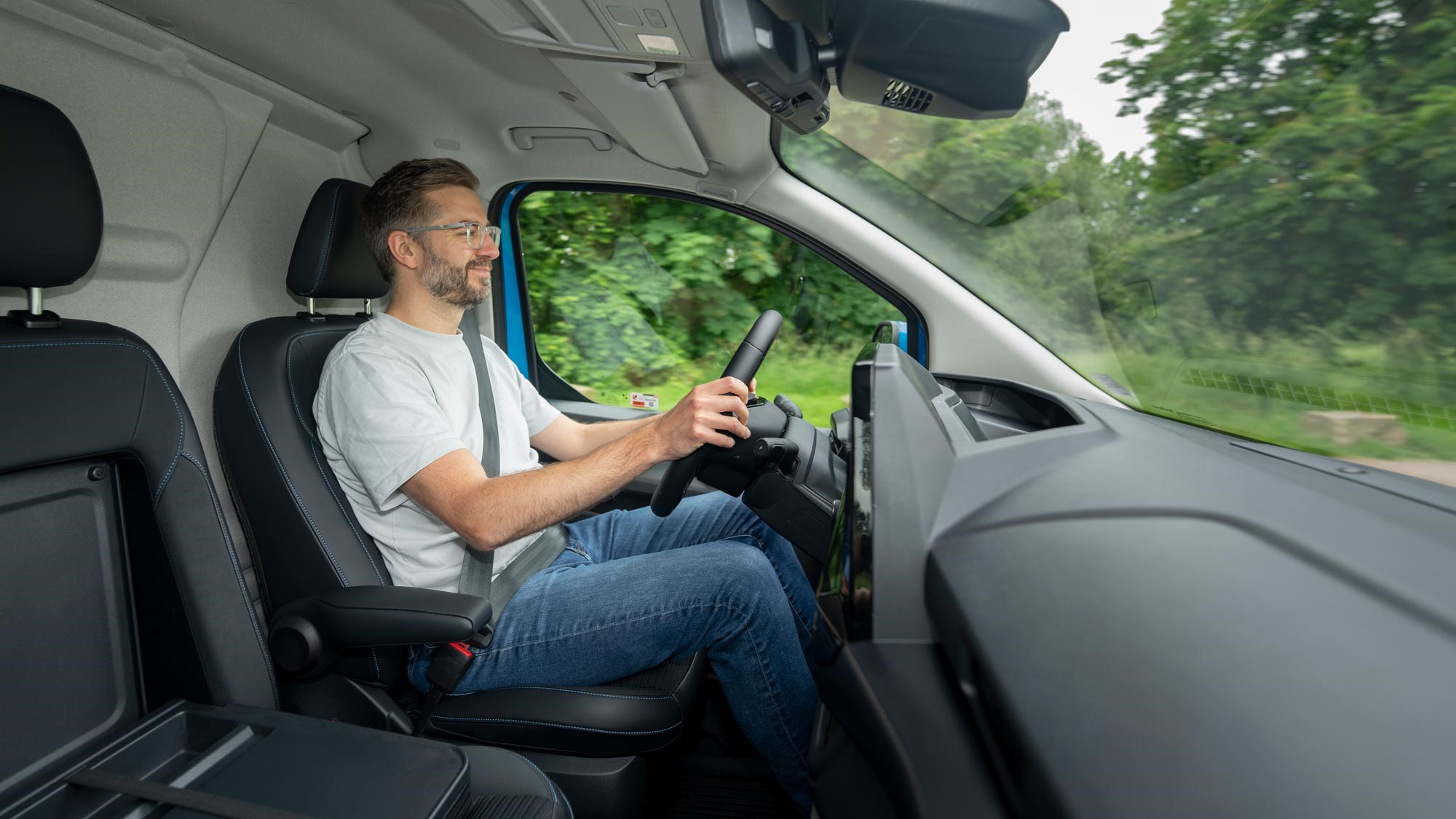
That purpose-build nature means that everything is seamlessly integrated out the back, too, so there is no loss of space in the loading bay. There are some more innovations out there too. Some are small, like the new integrated step that makes getting into the loading bay that bit easier, while some are huge, like the new L-shaped bulkhead in the Multicab version, which allows you two rear seats and a section of full-length loading bay to store longer things. Think a ladder or a few pipes, or possibly a thin canoe.
There is also a wide spectrum of versions to consider too. There might not be a base-level Leader trim, but there is an MS-RT performance model for the first time. Don’t get too excited, though. Despite it being the most powerful Transit Custom ever, it won’t set your world alight on the road – it’s more about the visuals.
What are the Ford E-Transit Custom’s specs?
Let’s get the statistic that you will be searching for out the way first – the official maximum electric range of the Ford E-Transit Custom is 209 miles. This is about par for the course in the medium-van sector, which is fine. It’s a bit of a shame that it doesn’t take a big stride forward in this area, but it’s harder to get the balance right in a van.
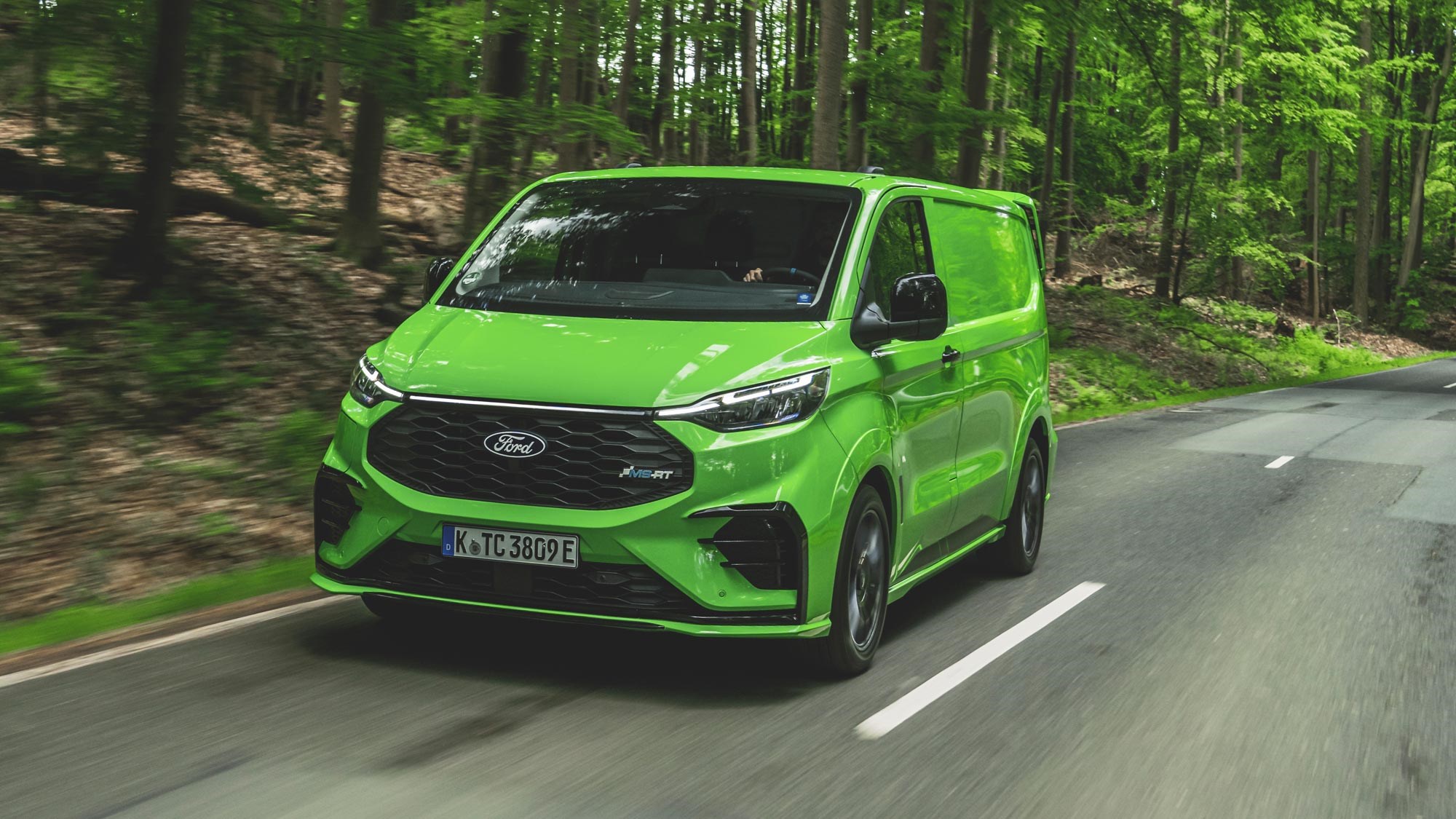
The bigger the battery, the more the van weighs and the less cargo it can carry, so there is always a bit of give and take to be had. While cars can pile on a few extra pounds without anyone really minding or even noticing, vans have to offer a decent payload.
In the E-Transit Custom’s case, the payload ranges from a high of 1008kg down to 990kg. This is again not too bad rather than excellent, but until battery technology improves this is the general ballpark in which the whole industry is operating.
There is only one battery available – a 64kWh unit – so you can’t choose between range and payload. This comes with a 5m three-phase Type 2 charging cable as standard, with a 10m version offered as an option.
How does the Ford E-Transit Custom drive?
We have long raved about the driving ability of Ford’s vans over the years – they have historically been the commercial vehicles that you can enjoy driving on the way back to the depot after the final drop of the day.
The E-Transit Custom continues this fine tradition, but with the same caveats that apply to the rest of the latest model’s range. To get this slight disappointment out of the way first, it is a shame that the steering has been made less sharp than it was in previous generations. This is done intentionally in a bid to make the van a bit more car like and potentially less intimidating to drive, so it does boost its abilities around town.
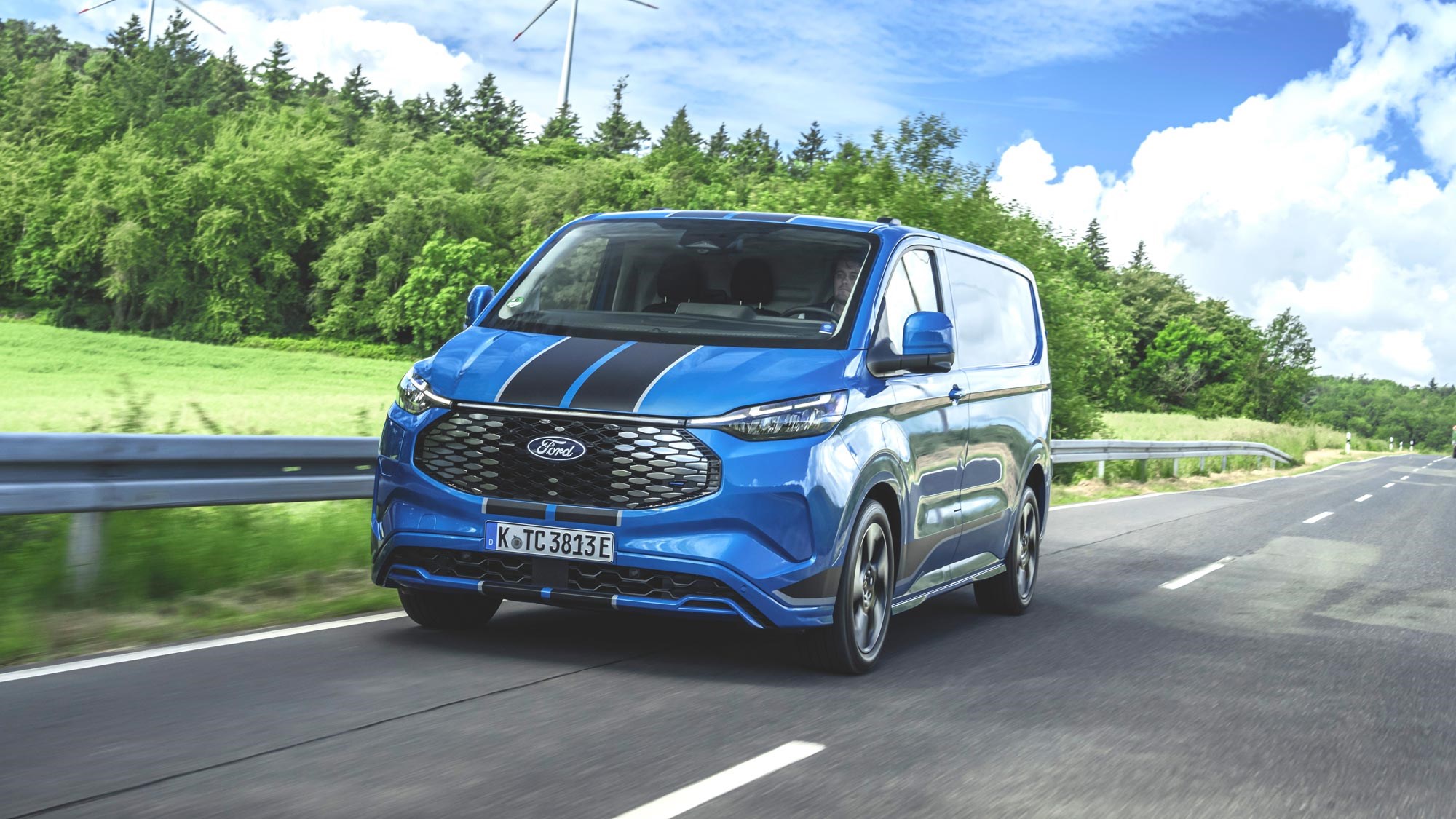
Otherwise, the E-Transit Custom is a fantastic van to drive. The ride is excellent and there is a wide range of visibility in all directions. Because there is no basic-trim version, the standard equipment includes front parking sensors and a rear parking camera, which makes urban manoeuvring that bit easier.
Unusually for an electric van, there is a choice between more than one motor. In fact, there are three to pick from. The one that will likely make up the majority of the sales to the big fleets that are ordering loads at once comes with 138bhp. We’ve yet to try that one, but we have been in the 221bhp model that comes on the Sport trim.
There are three driving modes – Eco, Normal and Sport – and each feels distinctly different to the others. There is the usual dialling back of accelerator responsiveness and climate functionality on the Eco, while the Sport brings a handy burst of pace. What there isn’t, though, is that instantaneous surge when you floor it from stationary, which is good news for those who have forgotten the straps to tie down the load in the back.
Instead, it offers a touch more when it comes to on-the-move speed, which helps it feel a bit nippier on slightly faster roads. It’s smooth and responsive rather than all-out-quick.
The same is true for the MS-RT. If you pick that one on the basis of its headline-grabbing 289bhp power output – the most for any Transit Custom ever – and are expecting serious pace then we have bad news. This isn’t a road-going Ford Supervan lite. It’s just a little bit more of the same, with a little more mid-range speed.
One thing that is missing is the ability to adjust the brake regeneration via paddles behind the steering wheel. Instead you get to press a button marked ‘L’ on the gear-selection stalk – it’s on, or off.
This won’t bring the van to a total halt on its own, but if that is what you want to do then there is a separate one-pedal mode. With a little practice you can drive it around town without touching the brakes at all.
It’s not as enjoyable on the motorway, though, where even the slightest lifting off of the accelerator sees the regenerative braking kicking in almost instantly. To maintain smooth progress you either have to keep a steady foot or pop it into cruise control.
What is the Ford E-Transit Custom like inside?
When the new Transit Custom launched, Ford talked about making it more car like, and this is most evident in the cabin. Given that the electric is almost exactly the same in the cabin as the diesel, we’ll not repeat ourselves too much here. Suffice to say that it is a spacious and well-designed interior with room for three adults and some clever touches such as that steering wheel table.
Rest assured, we did our best to try and flip it while on the move, and it simply won’t let you. The van’s gear selector has to be in P for the button (which is tucked on the back of the wheel on the bottom lip) to work. It works quickly too, as we discovered while seeing if we could flip it flat at a set of traffic lights and have it ready to drive on green. You can, but we’d stop short of getting out the table at the same time…
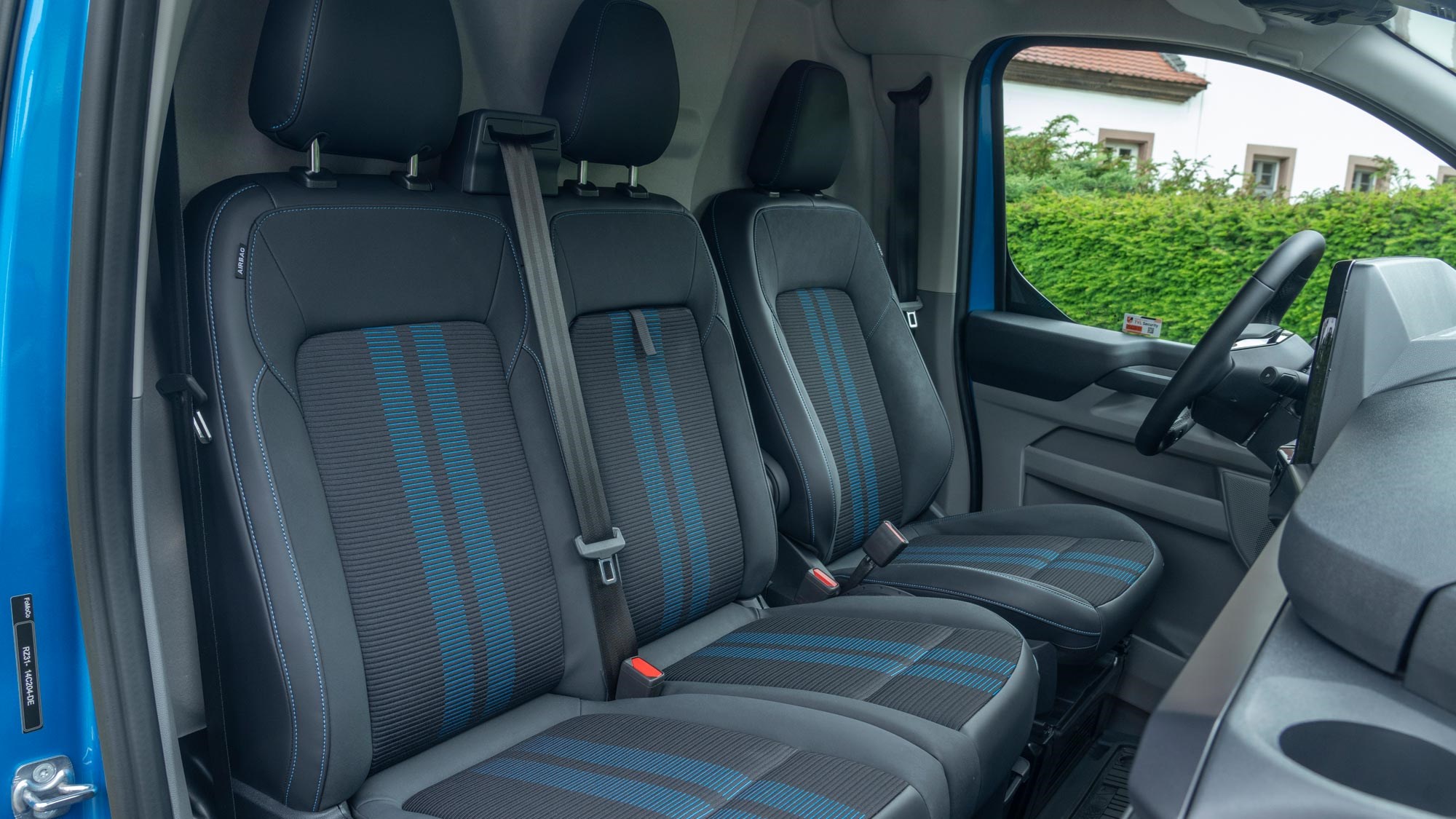
What we will touch on in more detail is Ford’s fabulous new Multicab version, which has two adult seats in the second row and an L-shaped bulkhead so you get a bit of full-length loading bay behind the driver.
Not only does this qualify as a commercial vehicle – something some crew cabs have had problems with in recent years – but it also gives you something genuinely unique in the sector.
There is a window on the sliding door, so it isn’t dark in the back, and the innermost seat has a handy bit of bulkhead to lean up against for a bit of a kip at the end of a long shift.
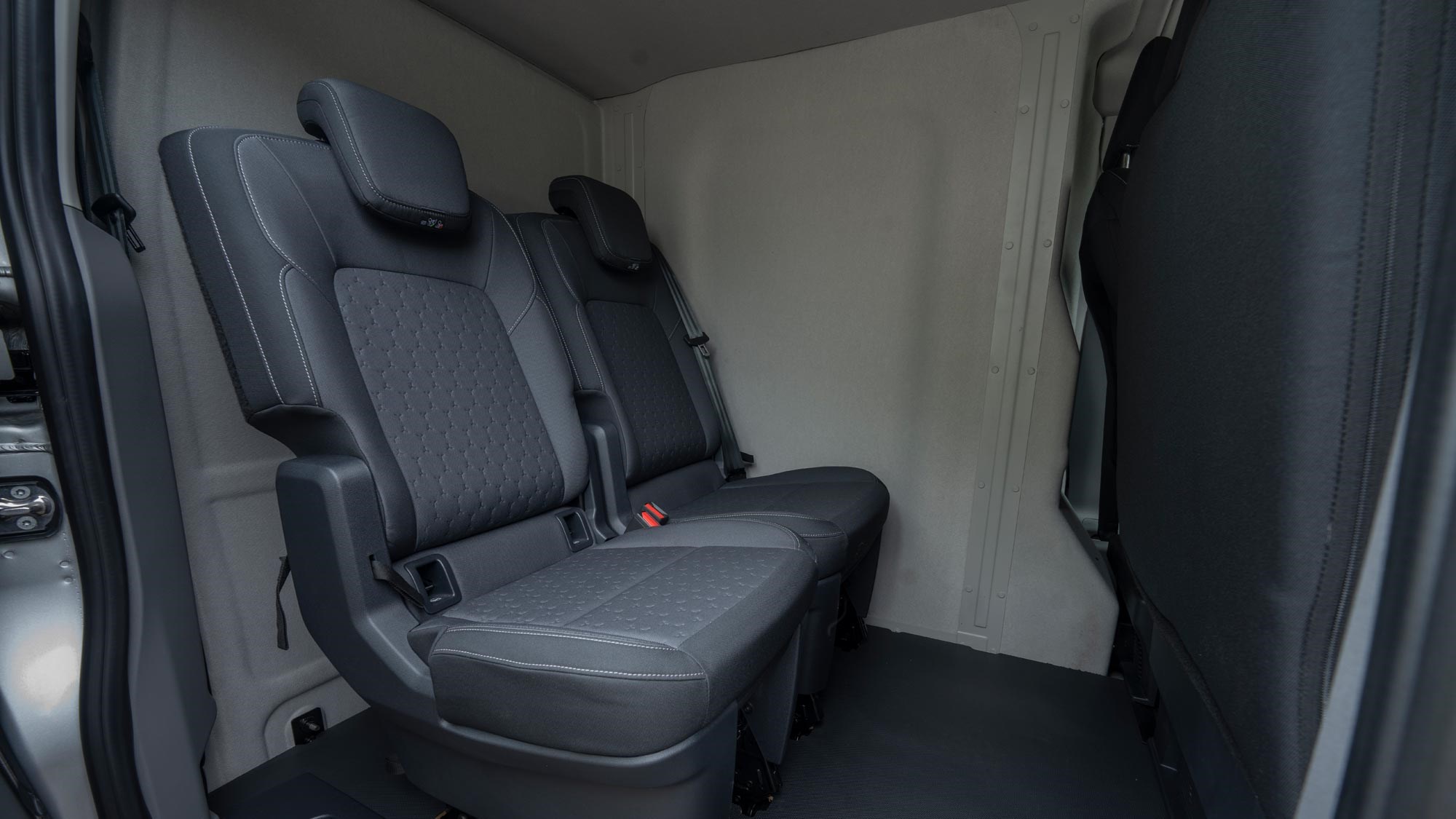
There’s even a small load-through hatch to elongate the storage that bit more. It isn’t the biggest of its kind, but that’s because it goes under the driver’s seat rather than the passenger seats as is often the case with such a hatch.
It’s also notable that Ford has achieved its previously stated goal and the Transit Custom range has earned a Platinum safety score from Euro NCAP – the highest possible. This is courtesy of the standard kit list featuring items such as a collision mitigation system, speed limiter, lane keeping aid and speed sign recognition.
Before you buy
There are four trims of Ford E-Transit Custom to pick from, if you include the MS-RT, which we do now that the tuning company has moved into the factory and works on the vans as they go through rather than taking a complete vehicle and modifying as it did before.
The result is a van that comes with the sort of kit that is far from necessary but is kinda fun. Think wild front and rear spoilers, lower side skirts, 19-inch alloy wheels, painted brake callipers, leather and suede front seats, ambient interior lighting and super-bright loading bay lights.
Whether it is worth the extra money from a business perspective is debatable, but then you aren’t going to buy choosing this version if you are thinking purely with an accountant’s head on. Live a little.
Verdict
The one thing holding us back from a wholehearted recommendation of the E-Transit Custom is the range. It’s a bit of a shame that it hasn’t been able to move the game on in that area, but it is bound more by the worlds of battery development and physics. Until batteries get much lighter, most vans will be operating in much the same area.
Otherwise, this is a brilliant electric van, which doesn’t feel compromised inside, on the road or in terms of its practicality. It’s reassuring that you can get it in so many different body shapes and styles.
Expect to see the number of electric vans on UK roads take a step up courtesy of this vehicle’s arrival.